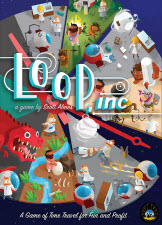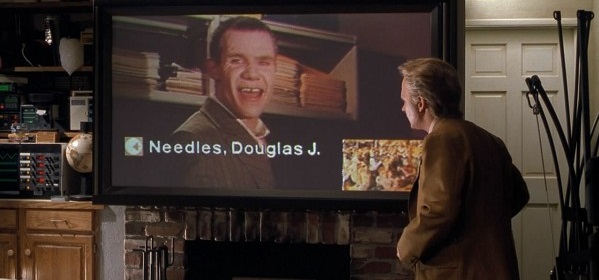McFly!
Now look here Mc..hey, wait a minute. You’re not McFly. You certainly look like him though. Then again, all our employees look the same to me…No bother. Look, how are we doing with our sales projections? What do you mean one of the time machines is offline for safety reasons? Get it back into use this afternoon ‘Not McFly’, or you won’t be here tomorrow…
Alright, so maybe we’re not actually reenacting one of Marty’s potential futures here, but if there’s one guy who knows a thing or two about having to avoid running into your other-other self while traveling through time, it would be him. Just think about it: at one point during the Back to the Future trilogy there are four Deloreans in existence in 1955. . .
Actually, try not to think about it; it’ll just get messy.
For a slightly easier implementation of reliving the same day over again, consider stepping into Loop, Inc., the latest game by designer Scott Almes. However, in this game you aren’t a bewildered teenager trying to get back home. Instead, you and the other players are employees of the profit-squeezing Mr. Loop and his cut-rate time travel tourism company. It’s not the greatest job ever, but it has a few perks. For one, you have the limitless potential to go to any point in history and share marquee moments of existence with your customers.
Or, as is more often the case, you can take the time machine out for a spin when the boss isn’t looking.
That, in a nutshell is what this inventive action-taking card game is all about. In Loop Inc., you are trying to maximize your effectiveness as an employee over the course of a single day by cramming in as many customer excursions as possible without unraveling that pesky space-time continuum thing. After all, what’s a little ripple in reality if it means you’re guaranteed the company’s quarterly bonus?
Loop Inc. begins by revealing a number of Trip cards, each depicting the possible places you’re able to send your clientele. From the beginning of life on Earth to the early 20th Century, all is possible. Want to hang out with cavemen? Got it. Experience the height of the Italian Renaissance? Got that too! Want to be there for the onset of the Black Death? Alright, maybe not – but the point is that you can! Well, so long as your customer is willing to pay and your handy dandy time machines are ready for the voyage.
You take these trips by acquiring and attaching the necessary components to your time machine. Each trip requires some combination of the game’s five different machine components, making the general premise of Loops Inc. remarkably simple. Go back in time. Get points. Win. Quick and easy, right?
Come now: this is time travel. When has that ever been simple?
Alright, adding the components to your time machines actually is simple and a bit of playful fun unto itself, letting you decide where to put your various pieces with no impact on the game. That said, while the idea of the game is indeed very straightforward, its inherent challenge – and continued appeal – is trying to accomplish its goal. So hang on to your frock coats, because we’re about to head in to the timey-wimey stuff.
Loop Inc. is played over three rounds that get progressively trickier to navigate each time. The game refers to these three rounds as Days, but in truth, you’re playing out the same day three times. This is key to understanding the time warp experience it puts you through.
Aside from the Trip cards and components themselves, Loop, Inc. centers around seven stacks of action cards lined up on the board, each of which provides a different ability. Three of them (Garage, Shop, and Armory) correspond to taking an available piece for one of your time machines from the game’s component board and attaching it to an undeployed time machine, while another three (Trash, Exchange, and Move) revolve around removing or altering pieces already attached. The final one, Advertise, is used to give you a competitive advantage over your fellow employees on said Trips by ‘locking in’ one Trip’s available slots for the Day.
During the first round, players take turns selecting an action card, using its ability, and placing it in front of them. At any point after using a card, players may always send an undeployed time machine on one of the Trips, so long as you have the right components to get there, no more than one other person has already gone on the same Trip that Day (travel limits on excursions and such), and that you haven’t already taken that same Trip previously. (because you’ve already gone / will go there).
During the first Day, you only have access to one time machine, but each successive Day gives you access to two and three, respectively, potentially letting you deploy to as many as six Trips in a single game.
After everyone has taken three cards, the first round ends, and everyone’s time machines deployed on a Trip that round scores the allotted points. Then, the components pool is reset and several unique action cards, called anomalies, are revealed for the taking.
What comes next is one of the two things that makes Loop, Inc. such a noteworthy game.
To start the second Day, everyone picks up the three cards from the previous round, ensuring they keep the order they were played the same. Much like not going back in time to kill your grandfather, these cards cannot be mixed up. The reason is that the second Day is played the same as the first, excepting that you will now take six actions instead of three. Of those six, three of them must be the cards in your hand, and they must be played in the order you did the previous round. You are free to intersperse the three new action cards among the previous ones, but as you are thematically replaying the same Day over again, you bound to ensure that what actions you took already are not altered for fear of undoing reality. Or worse, upsetting the boss.
The third round works the same way – only you now have three new actions alongside playing the previous six in the same order. At the end of those three rounds, the person with the most points wins.
Of course, then there’s the issue of negatively disrupting space-time. On the low end, you generate ‘waste’ in the form of inefficiency by not sending a time machine on a Trip where you placed one of your Ads, or you sent a machine on a Trip with more components than was necessary. These items merely become lost and convert into negative points. More drastically are the creation of tears in reality, a result of your careless stewardship of the time stream.
But hey, you gotta make a living, right?
Tears are created whenever you can’t take the action of a card you play, or you’re the second person to take the same Trip on the same Day. Can’t add a component because there aren’t any more items? Tear. Can’t exchange components on a time machine because it’s already launched today? Tear. Not only do acquiring tears turn into increasingly negative points, but should you ever attain four, your negligence erases you from existence – and the game.
This requirement of being forced to use cards in the same order all three times is quite novel, mostly because it turns the normally counterintuivitive notion of repeating the same actions over and over on its head by making it enjoyable. Unlike most games where this act would be boring and reductive, the necessity of having to repeat your actions in largely the same way gives the game more depth than it seems at first.
The other impressive part about Loop is how well it conveys the lesson of cause and effect. Loop Inc. not only teaches you the importance of planning ahead, but it also illustrates quite well (or sometimes quite painfully) how your decisions at the beginning of something can impact your results later on. Loop isn’t just a 45 minute game that caters to gamers and families alike, but it also inadvertently doubles as a good game about decision-making and basic project management. In that sense, Loop often feels like a shorter and more family-friendly version of Legacy: Gears of Time.
Loop Inc. always starts off seeming unfathomably easy, but by the end of it you’re often desperately trying to figure out how to get all of your time machines shipped out successfully. The game is easy to teach, and it’s surprising how often your early game decisions can come back to impact you later on. As such, it can take a couple playthroughs to really get the hang of Loop, Inc., but once you do, it cements itself as a well-engineered game that takes less than an hour to play. Like the Delorean, it has a lot of potential packed into a compact space. So if you like logic puzzles and think you have what it takes to be the best employee at Loop, Inc., then be sure to head over to the game’s Kickstarter.
You know, before time runs out.
[sc:Preview-Sealer ]
Photo Credits: Futurama by 20th Century Fox; Back to the Future by Universal Studios.

